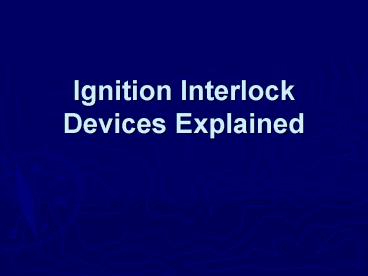Ignition Interlock Devices Explained - PowerPoint PPT Presentation
1 / 19
Title:
Ignition Interlock Devices Explained
Description:
... measure alcohol and prevent operation of a motor vehicle if too much alcohol is detected. ... trial services, the probations department or even members of ... – PowerPoint PPT presentation
Number of Views:147
Avg rating:3.0/5.0
Title: Ignition Interlock Devices Explained
1
Ignition Interlock Devices Explained
2
Texas DWI Statistics
- Texas was number 1 in 2003 in the number of
traffic fatalities involving alcohol. California
had 8 fewer alcohol related fatalities than
Texas. - In 1999, one out of every 150 miles driven on
Texas roads was driven by a person with a BAC
over .08. - Source National Highway Traffic Safety
Administration
3
Texas DWI Statistics
- Alcohol was a factor in 170,000 accidents
injuring 63,500 people in Texas in 1999. - Texans incurred over 10 billion in monetary and
property loss due to alcohol related collisions. - Each alcohol related fatality caused an estimated
3.3 million of economic damage.
4
Strategies for Making Roads Safer
- Reduce the BAC needed to prove intoxication from
.10 to .08. - Mandatory incarceration for 72 hours on
conviction of first DWI offense. - Zero tolerance if driver under 21 has any
detectable alcohol in their system. - Mandatory installation of Ignition Interlock
Devices (IIDs).
5
What is an IID?
- An IID is a mechanism designed to measure
alcohol and prevent operation of a motor vehicle
if too much alcohol is detected.
6
Where do you get an IID?
- An IID must be installed by one of six state
approved vendors. - Each vendor has licensed installers around the
state to install their IID mechanisms. - The State has approved eight different IID
mechanisms.
7
Are all IIDs the same?
- No, there are differences from mechanism to
mechanism. Each IID, however, shares some common
features - The ability to prevent a vehicle from operating
if the device measures BAC of over .03 - The ability to measure ethanol alcohol only
- The ability to give the driver multiple
opportunities to retest
8
Are all IIDs the same?
- If the driver fails multiple tests, the ability
to disable the vehicle for a period of time and - The ability to maintain a tamper proof record of
each start that can be downloaded monthly and
reported to the supervising court.
9
DWIs and Intoxication
- A person commits and offense if the person is
intoxicated while operating a motor vehicle in a
public place. Tex. Penal Code 49.04(a) - Intoxication means not having the use of mental
or physical faculties by reason of the
introduction of alcohol . . . or any other
substance in the body or having an alcohol
concentration of .08 or more. Tex. Penal Code
49.01(2)
10
The IID requirement
- Magistrates are required to order defendants
charged with a subsequent DWI offense - to install an IID unless the magistrate finds
that the installation of an IID would not be in
the best interest of justice and - not to operate any motor vehicle unless that
vehicle is equipped with an IID. TCCP art. 17.441
11
Are IIDs unconstitutional?
- Yes. The requirement to install an IID is an
infringement on the privilege of driving an
automobile. The revocation of drivers licenses
and privileges have not been found to be
punitive. The requirement to install is a less
severe infringement than license revocation and,
therefore, does not constitute punishment and is
not oppressive. - Ex Parte Elliott, 950 S.W.2d 714, 717 (Ft Worth
Court of Appeals, 1997)
12
Are IIDs unconstitutional?
- As an order requiring the installation of an IID
is not punishment, the order to install an IID
doe not constitute double jeopardy when the
defendant is later tried for the DWI. - Ex Parte Sells, 2000 Tex. App. Lexis 132 (Houston
Court of Appeals- 1st District, 2000)
13
The Magistrates IID Order
- The Magistrates Order should include
- A requirement that the defendant install an IID
- At the expense of the defendant
- Within 30 days of release on bail and
- Not operate any motor vehicle, unless the motor
vehicle is equipped with an IID.
14
The Magistrates Discretion not to Require an IID
- The magistrate has the discretion not to require
the installation of an IID if installation is not
in the best interests of justice. Reasons for
excusing the defendant from the IID requirement
include health and economic hardship. If the
requirement is not imposed, the judge should
enter an order to that effect.
15
If the Defendant does not Comply with the
Magistrates IID Order
- The magistrate may revoke the bond if the
magistrate finds by a preponderance of the
evidence that the defendant violated conditions
of the bond. TCCP art. 17.40
16
What happens after the Magistrates Order?
- The Magistrate is empowered to designate an
appropriate agency to install and monitor IID. In
some counties, the IIDs are monitored by
pre-trial services, the probations department or
even members of the judges staff.
17
Why does monitoring matter?
- Monitoring is key to the effective use of an IID
system to reduce drunk driving. Each month the
defendant reports to an IID center where the
information in the device is downloaded. A
monthly report is then transmitted to the
monitoring agent.
18
Why does monitoring matter?
- Based on the monthly report, the monitoring
officer can determine whether to recommend the
bond be modified to include - additional drug/alcohol counseling
- out-patient or in-patient treatment or
- increased court supervision.
19
Thank you and good luck!































